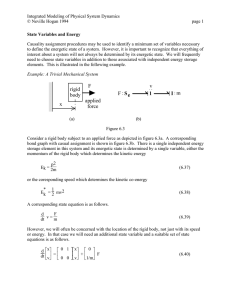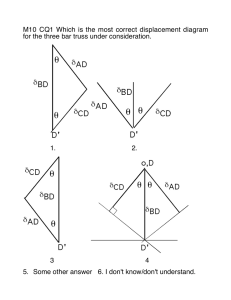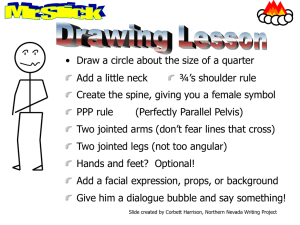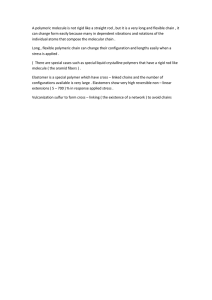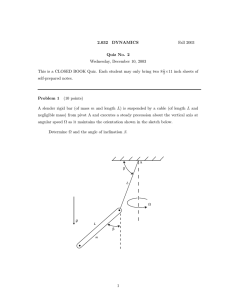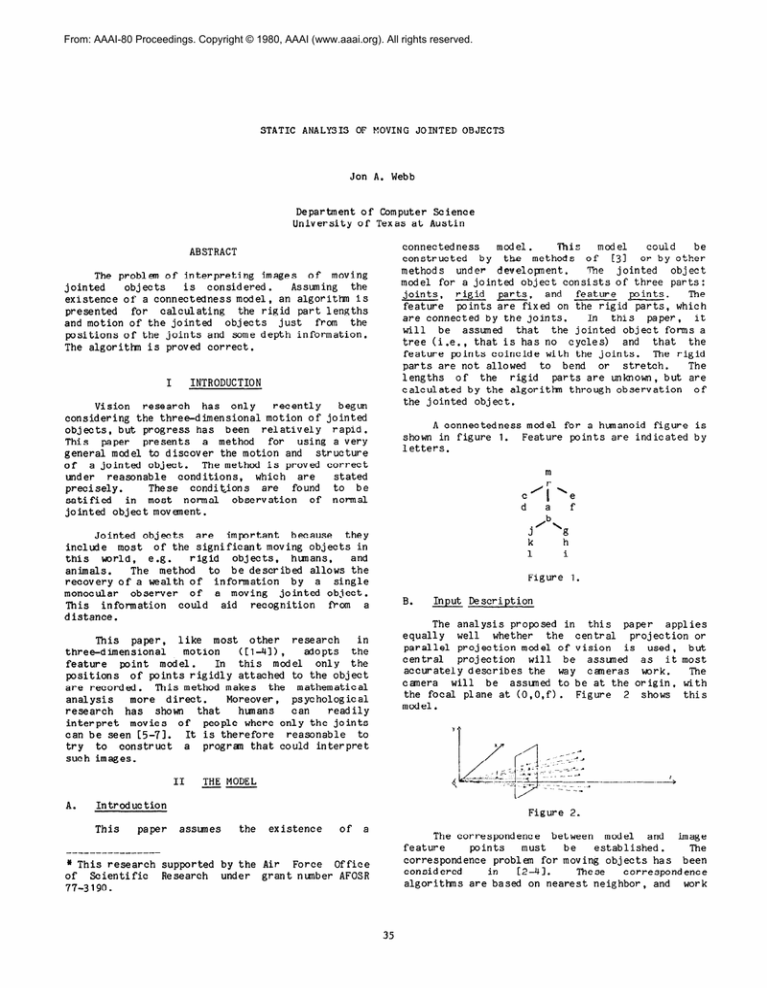
From: AAAI-80 Proceedings. Copyright © 1980, AAAI (www.aaai.org). All rights reserved.
STATIC ANALYSIS OF MOVING JOINTED OBJECTS
Jon A. Webb
Department of Computer Science
University of Texas at Austin
connectedness model.
This
model
could
be
constructed by the methods of [31 or by other
methods under development. The jointed object
model for a jointed object consists of three parts:
and -feature -points.
The
joints, rigid parts,
feature points are fixed on the rigid parts, which
are connected by the joints.
In this paper, it
will be assumed that the jointed object forms a
tree (i.e., that is has no cycles) and that the
feature points coincide with the joints. The rigid
parts are not allowed to bend or stretch.
The
lengths of the rigid parts are unknown, but are
calculated by the algorithm through observation of
the jointed object.
ABSTRACT
The problem of interpreting images of moving
jointed
objects
is considered.
Assuming the
existence of a connectedness model, an algorithn is
presented for calculating the rigid part lengths
and motion of the jointed objects just from the
positions of the joints and some depth information.
The algorithn is proved correct.
I
INTRODUCTION
Vision research has only
recently
begun
considering the three-dimensionalmotion of jointed
objects, but progress has been relatively rapid.
This paper presents a method for using a very
general model to discover the motion and structure
of a jointed object. The method is proved correct
under reasonable conditions, which are
stated
These condit,ions are
found to be
precisely.
satified in most normal observation of normal
jointed object movement.
A connectedness model for a humanoid figure is
shown in figure 1. Feature points are indicated by
letters.
m
?”
/i
f
j r’“\
k
1
i
Figure 1.
B.
Input Description
The analysis proposed in this paper applies
equally well whether the central projection or
parallel projection model of vision is used, but
central projection will be assuned as it most
accurately describes the way caneras work.
The
camera will be assuned to be at the or igin, with
the focal plane at (O,O,f>. Figure 2 shows this
model.
in
This paper, like most other research
three-dimensional motion
adopts the
(C1-41) *
In this model only the
feature point model.
positions of points rigidly attached to the object
are recorded. This method makes the mathematical
analysis more direct.
Moreover, psychological
readily
research has shown that
humans
can
interpret movies of people where only the joints
It is therefore reasonable to
can be seen 15-71.
try to construct a program that could interpret
such images.
A.
a
I.
Jointed objects are
important because they
include most of the significant moving objects in
rigid objects, hunans,
this world, e.g.
and
animals.
The method to be described allows the
recovery
of a wealth of information by a single
monocular observer of a moving jointed object.
This information could aid recognition from a
distance.
II
‘e
d
THE MODEL
--
Introduction
Figure 2.
This
paper
assumes
the
existence
of
a
The correspondence between model and image
feature
points must
be
established.
The
correspondence problem for moving objects has been
considered
in
These
c2-41.
correspondence
algorithms are based on nearest neighbor, and work
---------------* This research supported by the Air Force Office
of Scientific Research under grant nLpnberAFOSR
77-3190.
35
well ([31 reports 98% accuracy) for
small time intervals between them.
fraes
with
through the origin and (u,v,f), where f is
the focal length. This situation is shown
in figure 4. The coordinates of the ending
point under these assumptions can easily be
calculated using the quadratic formula.
The algorithm to be described requires a z
coordinate for some feature point in every frame.
This point will be called the reference point. For
simplicity, it will be assuned that the reference
point is the same in every frame. The z coordinate
of the reference point can be obtained by several
means, including the support assumption (used in
Cl1 for this purpose and proposed for psychological
method
is
entirely
reasons in [91> but no
satisfactory. This will be discussed briefly in
section IV.
III
A.
Figure 4.
This method gives two values
for
the
position of the end of the rigid part.
These two values represent two reflections
of the rigid part that could account for the
observed position of the ending point.
For
the algorithm to work, and calculate the
correct rigid part lengths, the correct
reflection must be chosen. It is assumed
that the correct reflection is always chosen
by some process.
While deciding which of
the reflections is correct might be a hard
problem (see section IV), once the correct
reflection is chosen it can be tracked
fairly easily since the two reflections
normally differ greatly in the z coordinate,
and in the angle they make at the starting
point.
THE ALGORITHM
Introduction
The algorithm treats the model as a tree with
the root being the reference point. Figure 3 shows
this tree for the humanoid model. _ The starting
.
point of a rigid part is its joint nearest the
reference point (in this tree); its ending point is
the joint farthest from the reference point. A
first rigid part is said to be above a second if it
lies on a path frcm the second to the reference
point. Similarly, the second is said to be below
the first.
a
f
d
2.
h
i
k
1
Figure 3.
The algorithn works by calculating the lengths
and the positions of the ending points of the
topmost rigid parts (these ending points are m, c,
e, and a in figure 4). Next, rigid part lengths
and ending point positions immediately below these
rigid parts are calculated. The process continues
until the positions of all the joints and the
rigid parts have been
all
the
lengths
of
calculated.
(1)
(2)
p=
(ux+vy+fz)
u2+v2+f2
The coordinates of the ending point are
The situation giving rise to
(Pu*Pv,Pf)
this formula is shown in figure 5.
l
Figure 5.
Formal Statement -of the Algorithm
Whenever a rigid part length is changed, the
previously calculated lower bounds on rigid
part lengths below the changed rigid part
become invalid, so they must be set to zero.
This action introduces an order dependence
into the algorithm; for the algorithm to
work correctly, the proper view of a rigid
part must be seen after the proper views of
rigid parts above it are
seen.
This
restriction will be discussed in greater
detail later.
For each frame, do the following for each
rigid part in the tree, going from top to bottom:
1.
r = SQRT[(x-p~~)~+(y-pv)~+(z-pf)~l
where
The calculation of the lengths of rigid parts
is done using known lower bounds on their lengths.
These lower bounds are obtained from previous
frames.
(In the first frame a lower bound of zero
is used). If the lower bound is too small to
account for the observed positions of the joints,
the smallest rigid part length that will work is
calculated and a new lower bound is established.
B.
If the quadratic formula yields no value for
the position of the end of the rigid part
this means that the rigid part length must
be longer than r.
Calculate a new lower
bound on the rigid part length by the
formula
Let the position of the starting point of
this rigid part be (x,y,z), the observed
coordinates of the ending point be (u,v>,
and the lower bound on the rigid part length
be r. If the rigid part length is exactly
rr then the ending point lies on a sphere of
radius r with center at (x,y,z>. At the
sane time, the ending point lies on a line
36
C.
Experimental Results
these restrictions can be removed.
An experiment was run using three hand-drawn
hunanoid figures and the algorithm given above.
The figures were drawn with specific rigid part
The rigid part lengths were
lengths in mind.
recovered by the algorithm to within an average
relative error of about lo-15%.
D.
V
A mathematical approach to the problem of
jointed object observation has been presented.
Given a connectedness model of the jointed object
to be observed, the actual three-dimensionalmotion
and rigid part lengths of the jointed object can be
discovered by observation of the jointed object.
This is done by constantly making
minimizing
assumptionqabout the object.
Proof of the Algorithm
---
It will now be shown that the algorithm will
eventually calculate the correct rigid part lengths
and three-dimensional joint positions. In order to
show this, these assunptions are necessary:
1.
The
correc
t
reflec
tions of the joints must
Further research must take into account the
actual motion of the object in a more sophisticated
In order to overcome
the deficiencies of the
my.
currently proposed method it is necessary to have a
more complete understanding of how objects can be
expected to move.
be
known.
2.
3.
SUMMARY
Each rigid part must be seen at some time in a
position that satisfies figure 6. That is, the
angle between the origin, the endpoint, and the
starting point of the rigid part must be a
right angle.
ACKNOWLEDGEMENTS
Fruitful discussions with J.
Larry Davis, Worthy Martin, and
gratefully acknowledged.
If rigid part A is above rigid part
B,
condition 2 must be satisfied for B after it is
satisfied for A.
K.
Agtw~l.
John Roach are
REFERENCES
Under the above conditions, the
Theorem.
givenwthm
will correctly calculate the length
and endpoint position for every rigid part.
Proof. Let R be a rigid part. The proof will
be by induction by the nLanberof rigid parts above
R. If there are no rigid parts above R then R is
As soon as
attached to the reference point.
condition (2) is satisfied for R formula (1) will
correctly calculate R's length and R's endpoint
will be correct.
If there are any rigid parts above R then
their correct
lengths and endpoint positions will
eventually be found.
Once this has happened,
conditions (3) guarantees that condition (2) will
be satisfied for R, at which time formula (1) will
be used to correctly calculate R's length. This
completes the proof.
IV
1.
Roberts,
"Machine
perception
of
L
G,
three-dimensional solids.11 in Optical and
electro-optical information processing, Jx
Tippett, et al., Eds., 159-197.
1965.
2.
Ullman, S, The interpretation of visual motion.
The MIT PreK
Cambridge, MA. 19r
3.
Rashid. R F. "Lights: A study in motion.11 In
Proc ---of the ARPA image understanding workshop,
Los Angeles, CA. 57-68.
November 1979.
4.
Roach, J W, Determining the three-dimensional
motion --and model of objez
from a sequence of
-images.
dissertation, University of
Ph.D.
Texas
at
Austin,
Department of Computer
Science. May 1980.
5.
Johansson, G, "Visual perception of biological
motion
and
a
model
for its analysis."
Perception and Psychophysics,2, (21, 201-211.
1973.
EXTENSIONS -TO THE ALGORITHM
6.
There are several restrictions placed on the
data available to the system that are undesirable
in the sense that hunans cannot make them in their
observation of jointed objects. The most serious
restrictions are the necessity of a connectedness
model
for
the
jointed
object,
needing
a
z-coordinate for the reference point in every
frame,
the
necessity of knowing the correct
reflections of the rigid parts, and the order
dependence in rigid part views. These restrictions
are necessary because the analysis of the moving
object is only static, and does not take into
account invariants in the object's motion. Dynamic
analysis of the moving object is under active
investigation and is yielding quite encouraging
results that suggest that most, and perhaps all, of
-
Kozlowski9 L T and J E Cutting, "Recognizing
the sex of a walker from dynamic point-light
displays .I1Perception and Psychophysics, 21,
(61, 575-580.
-
7.
Johansson, G, "Spatio-temporal differentiation
and integration in visual mot ion perception."
Psychological Research, 38, 379-383. 1976.
8.
Johansson, G and G Jansson9 "Perceived rotary
motion
from changes in a straight line."
Perception and Psychophysics,2, (3).
165-170.
1968.
9.
37
1977.
-
Gibson, J J, The perception of the visual
world. Houghtofiifflin Co., E!ozn,950.

